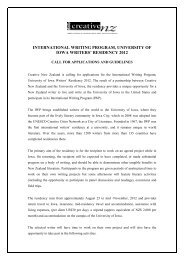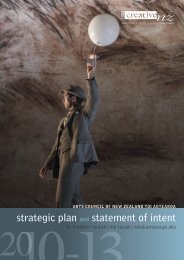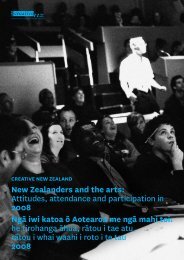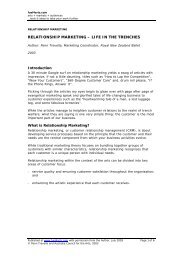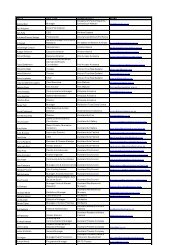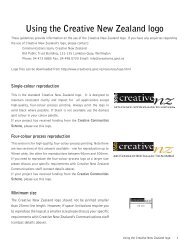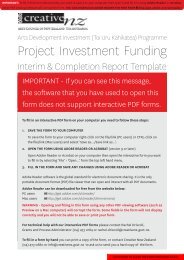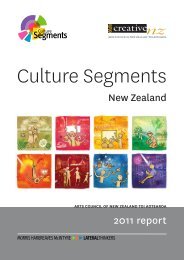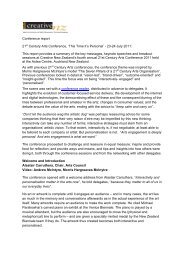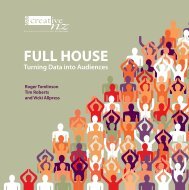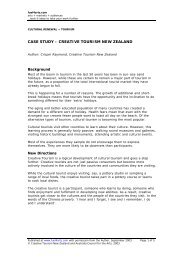Smart Arts - Creative New Zealand
Smart Arts - Creative New Zealand
Smart Arts - Creative New Zealand
- No tags were found...
You also want an ePaper? Increase the reach of your titles
YUMPU automatically turns print PDFs into web optimized ePapers that Google loves.
5A BOOKISBORNIt’s important toacknowledge all the workthat went into producingyour book.The commonlyused analogy of the birth ofa baby is apt, says writerJoan Rosier-Jones. A booklaunch is, therefore, like achristening.However, she continues,publishers will weigh theexpense of a launch againstthe possible benefits.Tothem, the purpose of alaunch is to generatepublicity and sales for thebook and so it helps toinvite the media to yourlaunch.You or the publishershould also send out a mediarelease and photo to literaryand/or arts editors, and alsoto your local newspaper, inplenty of time before thelaunch to meet theirdeadlines.If you’re a member of the<strong>New</strong> <strong>Zealand</strong> Society ofAuthors (PEN NZ Inc), itwill put a notice of yourbook launch and the fact thebook’s been published in itsweekly e-mail newsletter tomembers.Joan Rosier-Jones haswritten Publicising YourBook.See the Appendix fordetails.Media launchA media launch is an event where specific media are invited to a function and are briefedabout an upcoming show or exhibition. It can be costly and time-consuming to planthoroughly. It’s particularly effective for a large-scale festival that aims to communicate ageneric message (e.g. its programme) but a show will get more mileage by focusingdirectly on the media it wants to target. It means you can steer them towards a specificmessage. At a launch, you have less control over what is written.For visual arts, a media preview can be an effective and relatively inexpensive marketingtool. It’s a thank-you to the media you’ve been dealing with and an opportunity to attractwider media to an informal occasion. It’s as much about networking as it is about lookingat art. Make sure the curator, artist or someone knowledgeable about the exhibition iscirculating and talking about the work. Offering a mini-tour is also useful.Working with Mäori, Pacific and other specialistmediaWorking with media outside the mainstream and arts media can be an effective way to reachspecific target markets. Mäori media are particularly interested in arts events that coverMäori issues or in which Mäori artists have a prominent role. Likewise for Pacific media.If you’re promoting a Mäori artist, you should include the artist’s iwi (tribe) in any mediarelease. It’s important for a Mäori audience to know where that individual is fromthrough their tribal links.The Resources section of <strong>Creative</strong> <strong>New</strong> <strong>Zealand</strong>’s website (www.creativenz.govt.nz)includes a Media Contacts database, which is a good starting point for compiling a list ofMäori print, radio and television contacts.There are currently more than 20 iwi radio stations broadcasting throughout the country.Because Mäori is traditionally an oral culture, these radio stations are well-supported andare therefore an effective way to reach a wide Mäori audience. Iwi stations take a lot oftheir programming material in te reo Mäori from two main sources:• Ruia Mai provides the hourly news service as well as regular programmes• Mana <strong>New</strong>s provides half-hour programmes each week night. Mana <strong>New</strong>s also providesEnglish-language programming on Mäori issues to Radio <strong>New</strong> <strong>Zealand</strong>, which broadcastsWhenua, a magazine-style programme on Mäori issues giving good coverage to arts stories.Iwi radio stations often have free community noticeboards, which can be used toannounce community-based events.Mäori television programmes are also keen on arts stories but often require plenty ofadvance notice. This also applies to magazines such as Mana Magazine and Tu Mai. Ifyou’re not sure what lead-in time the various media require, it’s a good idea to find outat the outset of your marketing strategy.Mäori television and radio have, in varying degrees, a commitment to te reo Mäori butthey also broadcast in English. They often like to interview in both languages to reachtheir different audiences. Having a te reo Mäori speaker as part of your team greatlyenhances the ability for you to promote your show/event through Mäori media. At thevery least, the person promoting your show to Mäori should be familiar with basictikanga (customs and protocol) and te reo Mäori and be able to identify what it is aboutyour show/event that will attract Mäori audiences.<strong>Smart</strong> arts | Toi huatau56



